What “Level” does your car have?
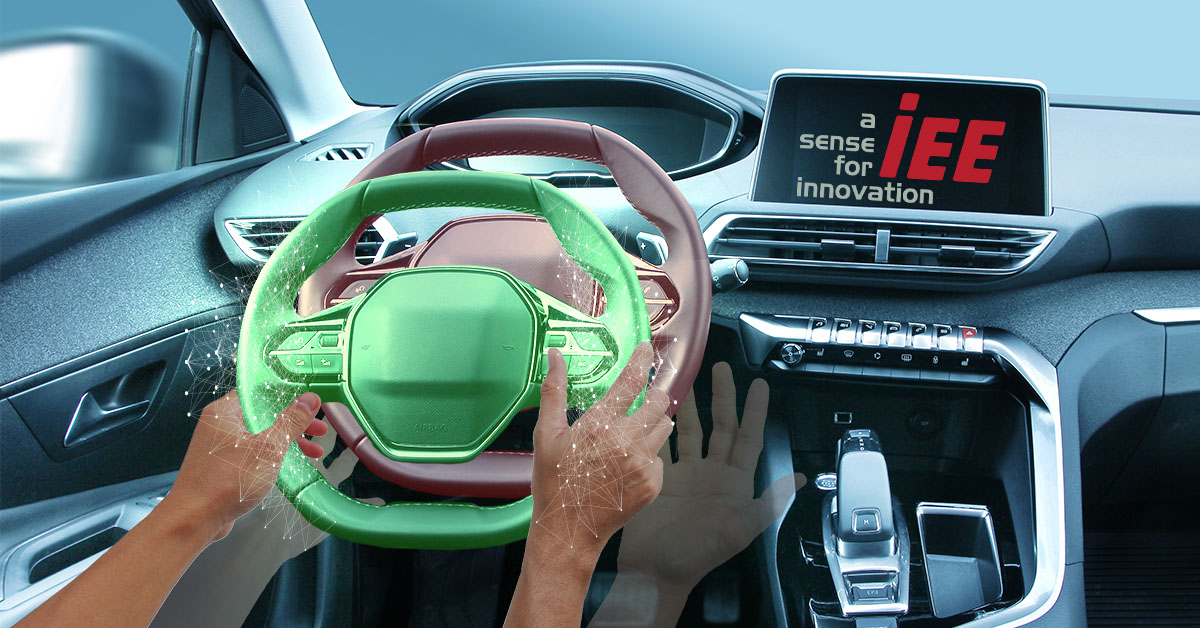
A major trend in the automotive industry is to increasingly equip vehicles with technology that aims at making the driving more comfortable by supporting the driver.
When you read or watch information in public media related to vehicles assisting the driver in its driving task or even driving autonomously, you may notice statements like “the car has Level 2 capabilities” or “vehicle manufacturer xy plans to launch a Level 4 vehicle in 2030”. But what are these “Levels”, what do they mean?
With increasing availability of driver assistance systems and following evolutions towards automated or even autonomous driving, the SAE (Society of Automotive Engineers) has “categorized” the systems, from Level 0 to Level 5. SAE J3016 defines the “Levels” depending on various key criteria: the capabilities of the vehicle, the role of the driver, and the variety of roads that the vehicle can handle.
 Level 0: In a simple way one can describe it as “manual” driving: the driver has to steer, accelerate and slow down the car, there is no system that could support him in these tasks. A Level 0 car may be equipped with safety features that can warn the driver (collision warning or lane departure warning), or act in emergency situations (Autonomous Emergency Braking, Emergency Lane Keeping). Still the car remains on a “0” Level as these systems do NOT continuously support the driver, they are no “assistance” systems but “safety” systems.
Level 0: In a simple way one can describe it as “manual” driving: the driver has to steer, accelerate and slow down the car, there is no system that could support him in these tasks. A Level 0 car may be equipped with safety features that can warn the driver (collision warning or lane departure warning), or act in emergency situations (Autonomous Emergency Braking, Emergency Lane Keeping). Still the car remains on a “0” Level as these systems do NOT continuously support the driver, they are no “assistance” systems but “safety” systems.
Level 1: The vehicle is equipped with a driver assistance system that can continuously support the driver in either lateral (steering) or longitudinal (braking, accelerating) control of the vehicle. Examples are Lane Keeping Assistance Systems or Lane Centring Systems (a camera detects the lane markings and the system continuously supports the driver to stay within the lane) or Adaptive Cruise Control (the distance to a preceding vehicle is measured, and the vehicle’s own speed can be adapted automatically to the speed of the preceding car).
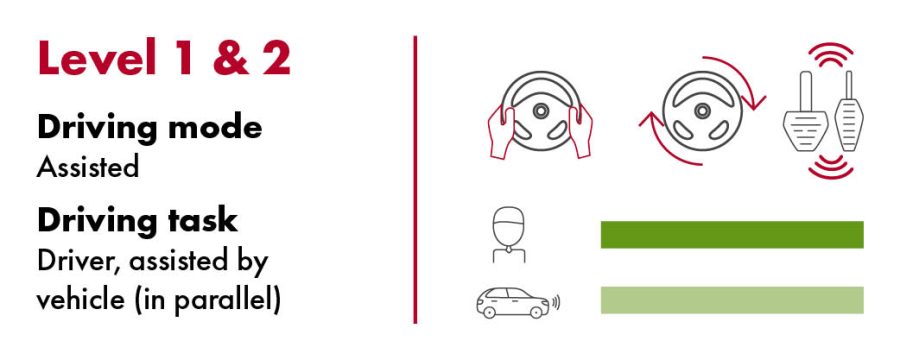 Level 2: The vehicle can continuously support the driver in longitudinal and lateral control, it “combines” two Level 1 features. Such Level 2 systems can take over a significant share of the “driving task”, and with this comes a problem on how drivers perceive such systems. Many may get the impression, and some are even convinced, that their car is self-driving, and that they can disengage from the driving task – social media is full of such examples of driver overreliance. Still, such Level 2 systems are only “assistance” systems. The driver is solely responsible for the control of the vehicle, has the task to monitor the traffic situation and needs to intervene to avoid a crash, if necessary. A Level 2 system must typically be driven “hands on”, the driver is not allowed to remove the hands from the steering wheel.
Level 2: The vehicle can continuously support the driver in longitudinal and lateral control, it “combines” two Level 1 features. Such Level 2 systems can take over a significant share of the “driving task”, and with this comes a problem on how drivers perceive such systems. Many may get the impression, and some are even convinced, that their car is self-driving, and that they can disengage from the driving task – social media is full of such examples of driver overreliance. Still, such Level 2 systems are only “assistance” systems. The driver is solely responsible for the control of the vehicle, has the task to monitor the traffic situation and needs to intervene to avoid a crash, if necessary. A Level 2 system must typically be driven “hands on”, the driver is not allowed to remove the hands from the steering wheel.
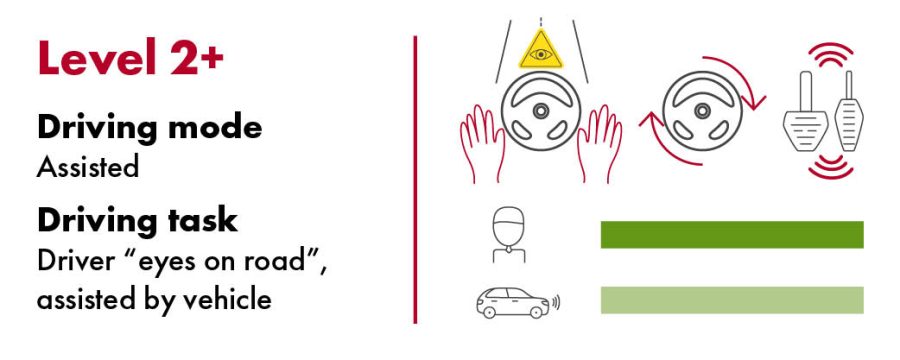 The description “Level 2+” is often used for vehicles that allow the driver to remove the hands from the steering wheel on certain roads and under the condition that the driver keeps his eyes on the road and is ready to intervene immediately in case of a need. The driver is not allowed to engage in tasks that would distract his attention from the traffic situation. Such Level 2+ vehicles still fall under the SAE taxonomy of Level 2. For now, only a limited number of countries allow such systems on their roads.
The description “Level 2+” is often used for vehicles that allow the driver to remove the hands from the steering wheel on certain roads and under the condition that the driver keeps his eyes on the road and is ready to intervene immediately in case of a need. The driver is not allowed to engage in tasks that would distract his attention from the traffic situation. Such Level 2+ vehicles still fall under the SAE taxonomy of Level 2. For now, only a limited number of countries allow such systems on their roads.
What all the “Levels” described so far have in common is that the driver is always liable in case of an incident, is fully responsible for the operation of the vehicle, usage of the assistance systems and monitoring of the traffic environment.
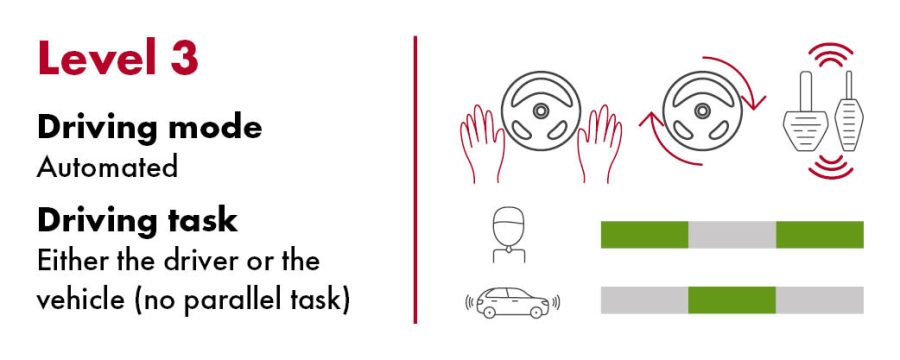 Level 3: Such a vehicle can be considered as a different “animal”, as now one moves from “assisted” driving into the world of “automated” driving. When the vehicle is capable to operate in Level 3 mode, the driver is allowed to disconnect from the driving task. He can be “hands off” and “eyes off” and engage in a secondary non-driving related task. However, the driver is not allowed to sleep or to leave the driver seat. He needs to remain available as a “fallback” to take back the driving control within a couple of seconds, if the vehicle requests him to do so. Under Level 3 operation the liability for incidents is with the vehicle, but as soon as the driver re-takes an active role in driving (e.g. steering), liability goes back to him. Hence it is crucial to precisely monitor who is in control of the vehicle (system or driver). Today a Level 3 operation of Automated Lane Keeping Systems, defined by UN regulation R157, is only allowed on highways! Beginning of 2022, the first R157 approved Level 3 vehicle entered the market and could be bought by end consumers.
Level 3: Such a vehicle can be considered as a different “animal”, as now one moves from “assisted” driving into the world of “automated” driving. When the vehicle is capable to operate in Level 3 mode, the driver is allowed to disconnect from the driving task. He can be “hands off” and “eyes off” and engage in a secondary non-driving related task. However, the driver is not allowed to sleep or to leave the driver seat. He needs to remain available as a “fallback” to take back the driving control within a couple of seconds, if the vehicle requests him to do so. Under Level 3 operation the liability for incidents is with the vehicle, but as soon as the driver re-takes an active role in driving (e.g. steering), liability goes back to him. Hence it is crucial to precisely monitor who is in control of the vehicle (system or driver). Today a Level 3 operation of Automated Lane Keeping Systems, defined by UN regulation R157, is only allowed on highways! Beginning of 2022, the first R157 approved Level 3 vehicle entered the market and could be bought by end consumers.
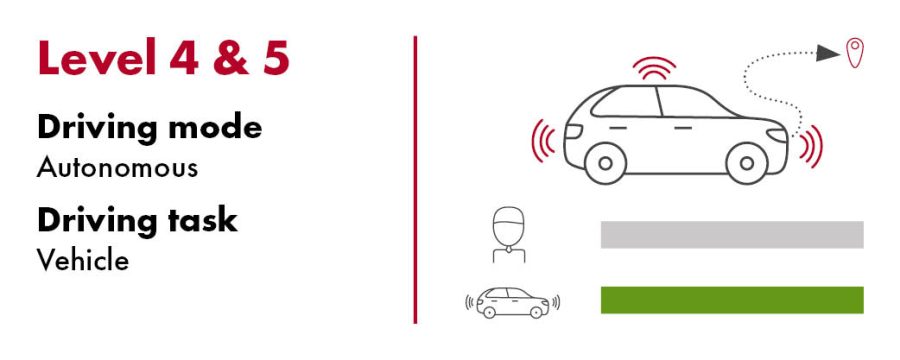 Level 4: With this next step one moves from “automated” to “autonomous” driving and a driver is potentially no longer needed. The driver can completely disconnect, sleep, or the vehicle might even be driverless. In case of an issue that does no longer allow a regular autonomous operation, the vehicle should bring itself into a safe situation. A limitation for Level 4 however is that such vehicles are not yet capable to ensure an autonomous operation on any kind of roads or under any driving/weather conditions. Level 4 vehicles are e.g. “roboshuttles” that operate in specific, well-defined areas. They typically run along a predefined route but cannot bring you to any destination of your choice. There are also “robotaxis” nowadays that have a broader flexibility in their operational environment, however, still with limitations. Level 4 vehicles may no longer have a steering wheel or pedals. No Level 4 passenger car is commercially available for end consumers at the moment, but some vehicle manufacturers are working on them.
Level 4: With this next step one moves from “automated” to “autonomous” driving and a driver is potentially no longer needed. The driver can completely disconnect, sleep, or the vehicle might even be driverless. In case of an issue that does no longer allow a regular autonomous operation, the vehicle should bring itself into a safe situation. A limitation for Level 4 however is that such vehicles are not yet capable to ensure an autonomous operation on any kind of roads or under any driving/weather conditions. Level 4 vehicles are e.g. “roboshuttles” that operate in specific, well-defined areas. They typically run along a predefined route but cannot bring you to any destination of your choice. There are also “robotaxis” nowadays that have a broader flexibility in their operational environment, however, still with limitations. Level 4 vehicles may no longer have a steering wheel or pedals. No Level 4 passenger car is commercially available for end consumers at the moment, but some vehicle manufacturers are working on them.
Level 5: This is the ultimate goal of fully autonomous driving. You can get into your vehicle, set a destination, and the vehicle will bring you there, no matter what kind of roads it needs to take, or what weather conditions. No further need for driver action, the car will do the job all alone until the end of the journey. Level 5 vehicles are a vision for the future, they do not exist today. They may be “pure” autonomous vehicles without any dedicated driver seat or driver controls, but they may also offer the full range of assistance or automation levels and the driver can chose whether he prefers to drive himself or to be driven.
IEE’s sensing solutions are a part of this assistance-automated-autonomous driving journey. Our Hands Off Detection (HOD) sensor is a crucial component to verify that the driver keeps his hands on the steering wheel when using a Lane Keeping Assist System (as Level 1 or Level 2 system), and it reliably monitors the transition between manual and automated driving for Level 3 vehicles. When owners of future Level 4 or 5 passenger cars are in the mood to drive themselves and use a lower Level mode, HOD will be there to verify their engagement in the driving task.
More on this topic: [SAE J3016, summarizing the key aspects of the different levels: SAE Levels of Driving Automation™ Refined for Clarity and International Audience]